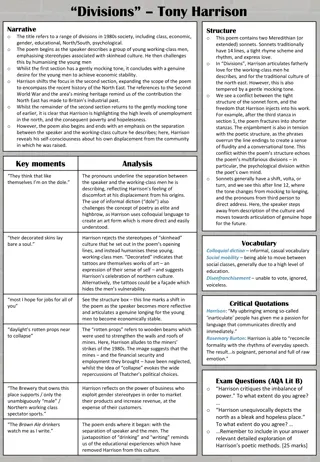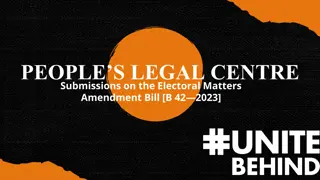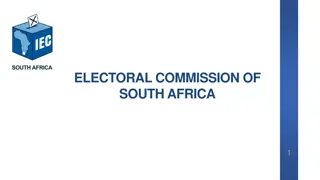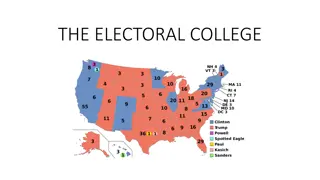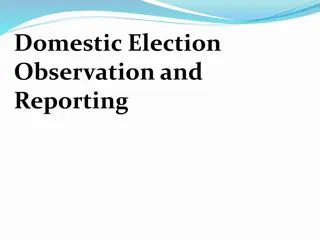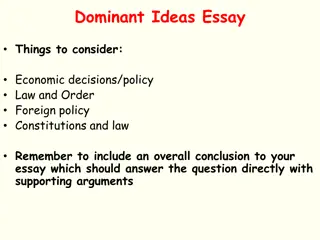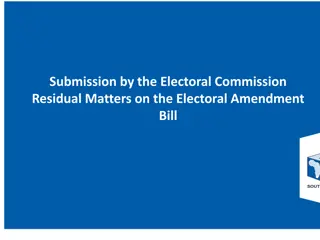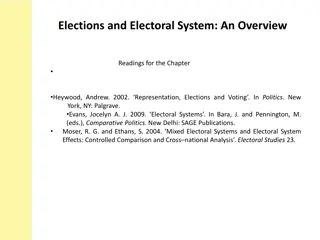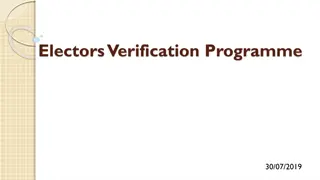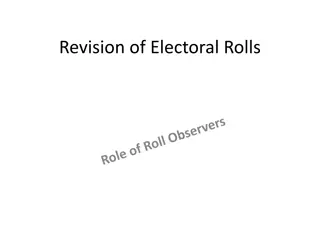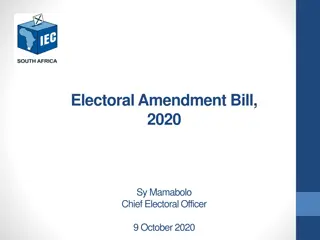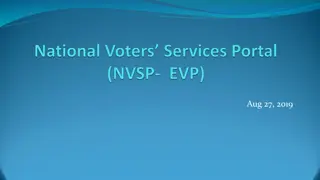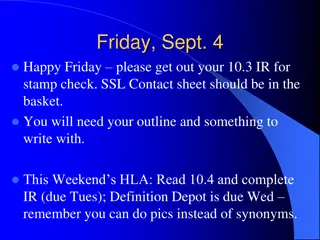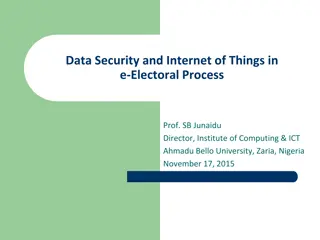The State of Electoral Hostility: Understanding and Addressing Societal Divisions
Delve into the complex realm of electoral hostility, exploring its impact on society, the evolving nature of perceptions, and potential consequences. Gain insights from comprehensive election studies in multiple countries and learn about the psychology behind hostility dynamics.
Uploaded on Sep 29, 2024 | 2 Views
Download Presentation

Please find below an Image/Link to download the presentation.
The content on the website is provided AS IS for your information and personal use only. It may not be sold, licensed, or shared on other websites without obtaining consent from the author.If you encounter any issues during the download, it is possible that the publisher has removed the file from their server.
You are allowed to download the files provided on this website for personal or commercial use, subject to the condition that they are used lawfully. All files are the property of their respective owners.
The content on the website is provided AS IS for your information and personal use only. It may not be sold, licensed, or shared on other websites without obtaining consent from the author.
E N D
Presentation Transcript
EPO Anniversary Event: The State of Electoral Hostility --- Houses of Parliament 2 February 2023 Michael Bruter
Overview Overview Happy Global Elections Day! Happy 3rd EPO anniversary! Thanks to our Chairs and guests Thanks to the ERC and the ESRC Celebrating ESRC Best International Impact Award
Methodology Methodology Election studies: 27 countries including 7 core Core: Parallel surveys of general population and first time voters Open end, explicit, and implicit questions Hostility Barometer: EPO and Opinium UK and US Family focus groups Individual interviews and first time voters interviews Experiments and quasi-experiments Coding of electoral atmosphere
Conceptual questions Conceptual questions What is electoral hostility? (and what is it not) How widespread is it and how is it evolving? How does it translate in people s every day life? Who do citizens blame for it? What are the political and societal consequences of hostility? What are the risks of hostility in terms of social cohesion, solidarity, and hopelessness?
What is hostility? What is hostility? Hostility grows on an identity triangle based on our perceptions of others, of how we think others see us (mirror perceptions) and perceptions of how society works and how it is evolving. Hostility is not polarization Hostility goes beyond partisanship, polarisation, or issues. It is about incompatible moral perceptions and visions of what society is and should be. It is unlikely to go anywhere in either the US or UK Hostility is a cycle of perpetually deteriorating emotions: it gets worse unless it gets better Hostility can translate into attitudinal and behavioural (e.g. unfriending, insults, or even threats or physical violence) reactions Hostility can lead to democratic frustration (Harrison) and hopelessness (Bruter) Hopelessness is a terrifyingly disinhibiting: things are so bad they probably can t get worse anyway opens every dangerous door
What is hostility? What is hostility? Hostility grows on an identity triangle based on our perceptions of others, of how we think others see us (mirror perceptions) and perceptions of how society works and how it is evolving MIRROR PERCEPTIONS PERCEPTIONS OF OTHERS PERCEPTIONS OF SOCIETY
What is hostility? What is hostility? Hostility is not polarization Hostility goes beyond partisanship, polarisation, or issues. It is about incompatible moral perceptions and visions of what society is and should be. It is unlikely to recede of its own AFFECTIVE POLARISATION HOSTILITY Stems from excessive in group identity Outgroup animosity does not entail ingroup identity Relates to partisan (possibly issue) identification Relates to irreconcilable conceptions of what society is and should be Genesis: 1) people identity with party, 2) those identities become increasingly strong and polarised, 3) identification with party becomes identification with partisans 4) identification with ingroup becomes rejection of outgroup Genesis: 1) Increasing proportions of people are critical of how society works, 2) This has first led to animosity towards politicians and elites, later towards institutions, and now towards regular citizens, 3) animosity deteriorates The more partisan people are the most likely to be hostile. Hostility is always towards the furthest ideology You can be hostile without being partisan, even without caring about politics Hostility can expand from opposite to close voters/worsen
What is hostility? What is hostility? Hostility is a cycle of perpetually deteriorating emotions: it gets worse unless it gets better Contempt (demobilising) And/or Disgust (mobilising) Hatred Anger Distrust Frustration Misunderstanding
An emotional sliding scale An emotional sliding scale Emotional sliding scale Frustration Distrust Anger Disgust Contempt Hatred US 6.00 5.00 4.00 FR SE 3.00 2.00 1.00 0.00 IT UK
Perceived evolution of hostility Perceived evolution of hostility Citizens see electoral hostility as significantly deteriorating (4.16 in South Africa to 5.47 in the US) Perception of growing hostility 7.00 6.00 5.00 4.00 3.00 2.00
Who is blamed for hostility? Who is blamed for hostility? Citizens primarily blame both extremist (6.49) and mainstream (6.27) politicians for hostility. However, they also blame both opposite (5.49) and like-minded (4.92) voters and to an extent even themselves (4.40) Who is to blame for electoral hostility? UK 8.00 Extremist politicians Mainstream politicians Journalists Voters for other parties Experts Foreign countries Voters for my parties You personally 7.00 6.00 5.00 4.00 3.00 IT US 2.00 1.00 0.00 ZA SE
What does hostility mean in What does hostility mean in real life? real life? Hostility can translate into attitudinal (e.g. dismissive: 68.7%, 68.6% angry) and behavioural (e.g. insults: 61.1% or even threats: 44.2%) reactions. Hostile attitudes and behaviours experiences at least once 80.00 70.00 60.00 50.00 40.00 30.00 20.00 10.00 0.00 Dismissive (all) Angry (all) Contempt (all) soc med unfriend (all) Insults (all) Threats (all) US IT SE ZA UK FR
Social consequences of hostility Social consequences of hostility People consider ostracising others due to electoral differences. 38% would consider no longer inviting them for dinner, 37.7% never speaking again, 31.1% physical fight What people would consider with opposite voters 40.00 35.00 30.00 25.00 20.00 15.00 10.00 5.00 0.00 Would stop inviting for dinner Would unfriend on soc med Would not want children to play together Could imagine insulting Could imagine never speaking again Could imagine physical fight US ZA IT UK FR SE
Political consequences of hostility Political consequences of hostility Around half of citizens consider that those who vote for a party they don t support should exclusively suffer the social, political and public service consequences of their vote Wanting opponents to suffer the consequences of their vote 60.00 50.00 40.00 30.00 20.00 10.00 0.00 Should suffer economic consequences Should suffer public service consequences Should suffer social consequences US ZA UK FR IT SE
The threat to solidarity The threat to solidarity Across countries between half and 2/3 would resent paying taxes to protect opposite voters when affected by policies they voted for. % Reconsidering solidarity with opposite voters 80.00 70.00 60.00 50.00 40.00 30.00 20.00 10.00
The danger of hostility The danger of hostility Hostility can have very dangerous consequences: It can threaten DEMOCRATIC RESOLUTION the sense that elections can bring closure to societal divisions; It can threaten the willingness of citizens to engage in SOLIDARITY with each other. It can lead to DEMOCRATIC FRUSTRATION (Harrison) It can lead to HOPELESSNESS (Bruter) a highly disinhibiting emotion which can lead citizens to consider behaviours they do not believe are solutions themselves
Thank you! Thank you!
EPO Election Studies and EPO Election Studies and EPO EPO- -Opinium Hostility Barometer Opinium Hostility Barometer Election studies: 27 countries including 7 core Core: Parallel surveys of general population and first time voters Core: Multi-year panel studies Open end, explicit, and implicit questions on hostility, frustration, atmosphere, emotions, memory, personality, behaviour, with separate ergonomics coding Typical samples 2,000 for general population + 500 first time voters survey Hostility Barometer: Regular joint operation by EPO and Opinium UK: started May 2019, 7 waves so far US: started May 2020, 2 waves so far Mix of time series core + wave-specific modules (frustration, elections under covid, Christmas dinners, electoral ergonomics, etc) Typical samples 2,000 with panel study component


![RE: ELECTORAL MATTERS AMENDMENT BILL [ B42-2023]](/thumb/18837/re-electoral-matters-amendment-bill-b42-2023.jpg)

